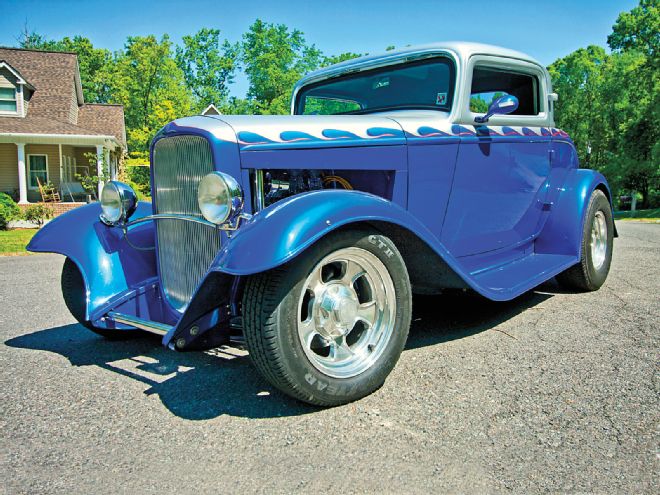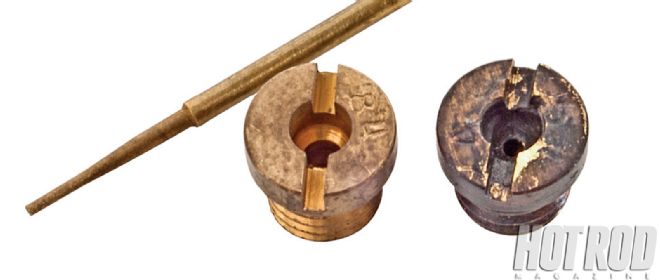
Pfafftown, North Carolina's Jeff Messer has owned his '32 Ford three-window coupe for five years. A TH350 automatic equipped with a 2,800-rpm-stall-speed converter transfers a GM crate 350 small-block's output back to a 2.79:1-geared, open, 8-inch Ford diff out of a '72 Maverick. The long-block is basically stock; the only major internal mod is a mild Comp Cams hydraulic flat-tappet cam. Topping off the engine is Messer's pride and joy: three custom-chromed Rochester two-barrel carbs on an Edelbrock 3x2 intake. The used carbs were from, as Messer puts it, "some guy's Corvette who wasn't happy with them."
As it turns out, neither was Messer. "At first, I thought it ran OK under full throttle," he relates. However, idle and off-idle transition were terrible. "It wouldn't idle down right and always had a gas smell. Adjusting the idle-mixture and curb-idle screws had almost no effect." Nothing seemed to help. The usual shops had no clue. Messer was stumped.
The basic problem was caused by trying to use three standard Rochester Model 2GC carbs in a Tri-power setup. That's just asking for trouble. It's not unusual for used carbs to come with their share of mechanical problems, but even if mechanically OK, the standard Rochesters have issues when used as outboard carbs on a custom Tri-power combo. The vast majority of Rochesters are calibrated for use in a single-carb installation on a low-level grocery-getter. Rare, original, "correct," factory Rochester Tri-power setups, as used on some Pontiac and Olds high-performance engines, had special, dedicated front and rear carburetors (Model 2G) without functional chokes, idle, or power circuits. True slaves, the throttle-blades on the original carbs were fully closed at idle.
"Real" Rochester Tri-power carbs also have a larger, 1-1/2-inch-bolt-center mounting pattern, but the Edelbrock small-block Chevy 3x2-barrel intake is machined for the smaller, 1-1/4-inch-bolt-center Rochester two-barrel. Forced to use end carbs with functional idle and power circuits, the system inevitably ends up over-rich at idle as well as during the transition to wide-open throttle (WOT).
Many Tri-power throttle-linkage kits also have the wrong linkage ratio. The outboard carbs don't open until the center carb is about 50 to 60 percent open; at this point, the center carb's linkage arm has caught up with the closed end carbs, and all three carbs pull to WOT. OE GM linkage setups were designed so that outboard carb actuation begins when the center carb's throttle linkage is about 40 percent open. An improper linkage ratio might result in a stumble or hesitation during quick WOT transition.
Joe's Garage, located just outside Winston-Salem, North Carolina, stepped up to tame the wild deuces. Owner Joe Kiser can fix just about anything, and he confirmed that turning the idle adjustment screws had no affect. "You wouldn't want to run this car in a closed garage," Kiser says. "You could smell it was extremely rich at idle." Overall, the car "lacked performance" and was "slow and sluggish." But at least the linkage was correct and properly adjusted.
Kiser saw the center carb's throttle blades weren't synchronized. "The carbs had been chromed," Kiser says. "During the chroming process, the shaft on the center carb got twisted. The righthand butterfly wouldn't close all the way." Tweaking the shaft using a crescent wrench for leverage, plus sanding the bore, set things right.
Both outboard carbs still had idle circuits. Relying on just the center carb for idle control, as originally intended by GM, requires deactivating the outboard carbs' idle circuits as well as ensuring their throttle blades are fully closed at idle to prevent residual air leakage.
Standard Rochester two-barrel throttle blades are thin, 0.041-inch-thick, brass or steel stampings that fit loosely in the throttle bore. That's normally OK on a single-carb grocery-getter because the throttle is never completely closed (if it were, the engine couldn't idle). The correct factory Rochester outboard carbs without a functional idle circuit had a thicker (0.075-inch), precision-fit throttle blade to better seal against the bore at closed throttle.
Although chroming had messed up the center carb's throttle blades, it proved advantageous on the end carbs: The added material left Kiser something to work with. By carefully sanding the bores and blades, he was able to precision-fit even the thin blades to the bores so they'd close completely with no visible daylight when held up to a light source. He blocked off the idle-mixture circuit with set screws and thread-locking compound.
For best WOT performance, Kiser found that the center carb needed slightly leaner jets, while the end carbs ran best with richer jets. With the idle fixed and the correct jet sizes installed, Kiser was "able to put the timing where it should be: 12 degrees initial, with 40 degrees total at 3,500 rpm."
"The sound of the motor is now completely different," Kiser reports. The three carbs idle smoothly, don't hesitate during transition, are stable at cruise, and fully turn on at WOT. Plus, the car is now fun to drive all the time. "We just got back from a stringent test drive, and I am absolutely happy," says a satisfied Messer.
Standard Rochester two-barrels are widely available at swap meets and wrecking yards, but you'll need to do some jetting and tuning to get them to run right on a custom, nostalgia Tri-power setup. Kiser advises, "If you do the swap-meet carb, play close attention to the butterflies and be sure to get the right linkage. Be prepared to block off the idle circuits on the end carbs. I do feel Rochesters are good all-round carbs. When they are dialed in, they are pretty much trouble free."
 Rochester two-barrel jets (right) are hard to find (Automotion is one source). In a pinch, Rochester Quadrajet four-barrel primary main jets (left) work in a Rochester two-barrel. The QJ jet's wide, beveled metering rod relief above the orifice entrance won't affect the jet's functionality in the two-barrel. But you can't go the other way: A stepless Rochester 2G jet won't work in a Q-jet.
Rochester two-barrel jets (right) are hard to find (Automotion is one source). In a pinch, Rochester Quadrajet four-barrel primary main jets (left) work in a Rochester two-barrel. The QJ jet's wide, beveled metering rod relief above the orifice entrance won't affect the jet's functionality in the two-barrel. But you can't go the other way: A stepless Rochester 2G jet won't work in a Q-jet.